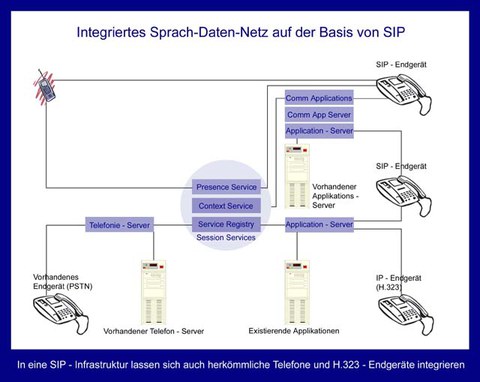SIP (Session Initiation Protocol)
General
- original title "Application-level protocol for inviting users to multimedia conferences [emphasis ours]"
"multimedia conferences..." in the title means multicast conferences á la M-Bone;
now known as "SIP: Session Initiation Protocol" - originally SIP has been a point-to-point version of SAP (Session Announcement Protocol) and was intended as a general solution for WANs
- 1996 SIP Internet Draft introduced
- 1999 adopted as RFC 2543 by IETF
- SIP is based on HTTP and SMPT
- used already 1999 in the MBone-Tools
Conceptional Basics
- originally designed in order to enable the dial-up
- lower demands on infrastructure (administration of session information consequently in end device)
- no support for multimedia & data applications
- lacks possibilities of conference control
- every user has a protocol client (initiating calls) and a protocol server (answering calls).
- The network server consisting of proxy and redirect server is responsible for transmission and redirection.
General Composition
Essential Commandos
- "Invite" initiates a call
- "Options" can contain additional information about the user
- "Ack" confirms reliable communication
- "Register" transmits location information to an SIP server
- "Cancel" tries to delete an already sent request
- "Bye" closes the conference
Advantages
- SIP can split a received call to several end devices (so-called "forking")
- fast dial up because of simultanious transmission of demands of a session and characteristics of the client
- addressing scheme very flexible: uses information from existing DNS systems
- address is similar to e-mail: user@company.com
Disadvantages
- security of the protocol still improvable
- forking between different producers still not completely reliable
- integration in a private branch exchange still difficult
- often trouble with Voice-Mail
- trouble with NAT and low bandwidth
Documents
- SIP: Session Initiation Protocol (RFC 2543)
- SDP: session description protocol (RFC 2327)
- Hypertext transfer protocol -- HTTP/1.1 (RFC 2068)
- Multipurpose Internet Mail Extensions (MIME) Part One: Format of Internet Message Bodies (RFC 2045)
- The Use of URLs as Meta-Syntax for Core Mail List Commands and their Transport through Message Header Fields (RFC 2396)
- Uniform Resource Locators (URL) (RFC 1738)
- UTF-8, a transformation format of ISO 10646 (RFC 2279)
- Augmented BNF for Syntax Specifications: ABNF (RFC 2234)
- Standard for the format of ARPA internet text messages (RFC STD 11)

